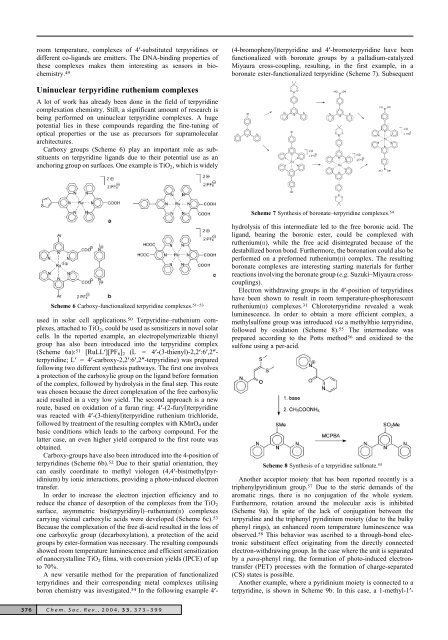Digital version
Digital version
Digital version
You also want an ePaper? Increase the reach of your titles
YUMPU automatically turns print PDFs into web optimized ePapers that Google loves.
376<br />
room temperature, complexes of 4A-substituted terpyridines or<br />
different co-ligands are emitters. The DNA-binding properties of<br />
these complexes makes them interesting as sensors in biochemistry.<br />
49<br />
Uninuclear terpyridine ruthenium complexes<br />
A lot of work has already been done in the field of terpyridine<br />
complexation chemistry. Still, a significant amount of research is<br />
being performed on uninuclear terpyridine complexes. A huge<br />
potential lies in these compounds regarding the fine-tuning of<br />
optical properties or the use as precursors for supramolecular<br />
architectures.<br />
Carboxy groups (Scheme 6) play an important role as substituents<br />
on terpyridine ligands due to their potential use as an<br />
anchoring group on surfaces. One example is TiO2, which is widely<br />
Scheme 6 Carboxy-functionalized terpyridine complexes. 51–53<br />
used in solar cell applications. 50 Terpyridine–ruthenium complexes,<br />
attached to TiO2, could be used as sensitizers in novel solar<br />
cells. In the reported example, an electropolymerizable thienyl<br />
group has also been introduced into the terpyridine complex<br />
(Scheme 6a): 51 [RuLLA][PF6]2 (L = 4A-(3-thienyl)-2,2A:6A,2Bterpyridine;<br />
LA = 4A-carboxy-2,2A:6A,2B-terpyridine) was prepared<br />
following two different synthesis pathways. The first one involves<br />
a protection of the carboxylic group on the ligand before formation<br />
of the complex, followed by hydrolysis in the final step. This route<br />
was chosen because the direct complexation of the free carboxylic<br />
acid resulted in a very low yield. The second approach is a new<br />
route, based on oxidation of a furan ring: 4A-(2-furyl)terpyridine<br />
was reacted with 4A-(3-thienyl)terpyridine ruthenium trichloride,<br />
followed by treatment of the resulting complex with KMnO4 under<br />
basic conditions which leads to the carboxy compound. For the<br />
latter case, an even higher yield compared to the first route was<br />
obtained.<br />
Carboxy-groups have also been introduced into the 4-position of<br />
terpyridines (Scheme 6b). 52 Due to their spatial orientation, they<br />
can easily coordinate to methyl viologen (4,4A-bis(methylpyridinium)<br />
by ionic interactions, providing a photo-induced electron<br />
transfer.<br />
In order to increase the electron injection efficiency and to<br />
reduce the chance of desorption of the complexes from the TiO2<br />
surface, asymmetric bis(terpyridinyl)–ruthenium(II) complexes<br />
carrying vicinal carboxylic acids were developed (Scheme 6c). 53<br />
Because the complexation of the free di-acid resulted in the loss of<br />
one carboxylic group (decarboxylation), a protection of the acid<br />
groups by ester-formation was necessary. The resulting compounds<br />
showed room temperature luminescence and efficient sensitization<br />
of nanocrystalline TiO2 films, with con<strong>version</strong> yields (IPCE) of up<br />
to 70%.<br />
A new versatile method for the preparation of functionalized<br />
terpyridines and their corresponding metal complexes utilising<br />
boron chemistry was investigated. 54 In the following example 4A-<br />
Chem. Soc. Rev., 2004, 33, 373–399<br />
(4-bromophenyl)terpyridine and 4A-bromoterpyridine have been<br />
functionalized with boronate groups by a palladium-catalyzed<br />
Miyaura cross-coupling, resulting, in the first example, in a<br />
boronate ester-functionalized terpyridine (Scheme 7). Subsequent<br />
Scheme 7 Synthesis of boronate–terpyridine complexes. 54<br />
hydrolysis of this intermediate led to the free boronic acid. The<br />
ligand, bearing the boronic ester, could be complexed with<br />
ruthenium(II), while the free acid disintegrated because of the<br />
destabilized boron bond. Furthermore, the boronation could also be<br />
performed on a preformed ruthenium(II) complex. The resulting<br />
boronate complexes are interesting starting materials for further<br />
reactions involving the boronate group (e.g. Suzuki–Miyaura crosscouplings).<br />
Electron withdrawing groups in the 4A-position of terpyridines<br />
have been shown to result in room temperature-phosphorescent<br />
ruthenium(II) complexes. 31 Chloroterpyridine revealed a weak<br />
luminescence. In order to obtain a more efficient complex, a<br />
methylsulfone group was introduced via a methylthio terpyridine,<br />
followed by oxidation (Scheme 8). 55 The intermediate was<br />
prepared according to the Potts method 56 and oxidized to the<br />
sulfone using a per-acid.<br />
Scheme 8 Synthesis of a terpyridine sulfonate. 55<br />
Another acceptor moiety that has been reported recently is a<br />
triphenylpyridinium group. 57 Due to the steric demands of the<br />
aromatic rings, there is no conjugation of the whole system.<br />
Furthermore, rotation around the molecular axis is inhibited<br />
(Scheme 9a). In spite of the lack of conjugation between the<br />
terpyridine and the triphenyl pyridinium moiety (due to the bulky<br />
phenyl rings), an enhanced room temperature luminescence was<br />
observed. 58 This behavior was ascribed to a through-bond electronic<br />
substituent effect originating from the directly connected<br />
electron-withdrawing group. In the case where the unit is separated<br />
by a para-phenyl ring, the formation of photo-induced electrontransfer<br />
(PET) processes with the formation of charge-separated<br />
(CS) states is possible.<br />
Another example, where a pyridinium moiety is connected to a<br />
terpyridine, is shown in Scheme 9b. In this case, a 1-methyl-1A-

















